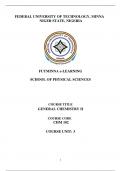FEDERAL UNIVERSITY OF TECHNOLOGY, MINNA
NIGER STATE, NIGERIA
FUTMINNA e-LEARNING
SCHOOL OF PHYSICAL SCIENCES
COURSE TITLE
GENERAL CHEMISTRY II
COURSE CODE
CHM 102
COURSE UNIT: 3
1
, Course Coordinator
Dr. E.Y. Shaba
Department of Chemistry
Federal University of Technology, Minna
Niger State, Nigeria
COURSE DEVELOPMENT TEAM
Subject Matter Experts Dr. E.Y. Shaba
Dr. M. T. Bisiriyu
Dr. S. Mustapha
Dr. E. Tanko
Dr. S. T. Dafa
Course Coordinator Dr. E.Y. Shaba
Department of Chemistry
FUT Minna, Nigeria
Dr. M. T. Bisiriyu
Instructional Designers Dr. S. Mustapha
Department of Chemistry,
Federal University of Technology, Minna,
Nigeria
ODL Experts Prof. Amosa Isiaka GAMBARI
Dean of School Prof. M. Jiya
School of Physical Sciences
CHM 102 STUDY GUIDE
2
, INTRODUCTION
CHM 102 General Chemistry II is a 3 - credit unit course for students studying towards
acquiring a Bachelor of Technology in any field. The course is divided into 7 modules and 20
study units. It begins with brief historical development of organic chemistry and importance
of the compounds as well as the characterizations techniques of organic compounds.
Thereafter, bonding in organic compounds, chemistry of functional groups (alkane, alkenes,
alkynes and aromatic hydrocarbons), non-aromatic hydrocarbons (alkyl halides, alcohols,
carbonyl compounds and carboxylic acids, and as well as its derivatives) are discussed. Also,
the concept of reaction mechanism, kinetics and stereochemistry will be introduced. Finally,
the student is introduced to the chemistry of selected metals and non-metals, and the
transition metals.
The course guide therefore gives you an overview of what CHM 102 is all about, the
textbooks and other materials to be referenced, what you are expected to know in each unit,
and how to work through the course material.
RECOMMENDED STUDY TIME
This course is a 3-credit unit course having 25 study units. You are therefore enjoined to
spend at least 3 hours in studying the content of each study unit.
WHAT YOU ARE ABOUT TO LEARN IN THIS COURSE
The overall aim of this course, CHM 102 is to introduce you to basic concepts of General
Chemistry II. At the end of this course, you should be able to:
i. Describe the brief history of development of organic chemistry and its importance
ii. Explain the characterizations techniques of organic compounds
iii. Describe the bonding in organic compounds
iv. Explain the chemistry of Alkane, Alkenes, Alkynes, and Aromatic Hydrocarbons
v. Identify non-aromatic hydrocarbons and their reactions
vi. Describe the concept of Reaction Mechanism, Kinetics and Stereochemistry
vii. Describe metals, non-metals and transition metals
COURSE AIMS
3
, This course aims to introduce students to the basic concepts of General Chemistry lI. It is
expected that the knowledge will enable the reader to effectively use the knowledge of
general organic chemistry in his/her profession life.
COURSE OBJECTIVES
It is important to note that each unit has specific objectives. Students should study them
carefully before proceeding to subsequent units. Therefore, it may be useful to refer to these
objectives in the course of your study of the unit to assess your progress. You should always
look at the unit objectives after completing a unit. In this way, you can be sure that you have
done what is required of you by the end of the unit.
Moreover, below are overall objectives of this course. On completing this course, you should
be able to:
(i). define organic chemistry
(ii). account for the history of organic chemistry and synthesis of urea
(iii). list and explain different methods of isolating organic compounds
(iv). list and explain different methods of purification of isolated organic compound
(v). explain both qualitative and quantitative techniques for characterizing organic
compounds
(vi). list the steps involved in the identification of organic compounds
(vii). identify fullerenes as the fourth allotrope of carbon
(viii). describe the forms and shape fullerenes (C60)
(ix). mention the properties of fullerenes
(x). list the applications/uses of fullerenes
(xi). describe covalent bonds
(xii). define bond length and bond strength
(xiii). differentiate between sigma bond and pi bonds
(xiv). explain the formation of sp3, sp2 and sp orbitals
(xv). identify the hybridization present in an organic compound
state the characteristics of all hybridised orbitals
(xvi). give a general classification of organic compounds
(xvii). explain the criteria for the classification of organic compounds
(xviii). identify different types of carbon present in an organic compound
(xix). draw structural formula
(xx). give a condensed form of any compound
4





